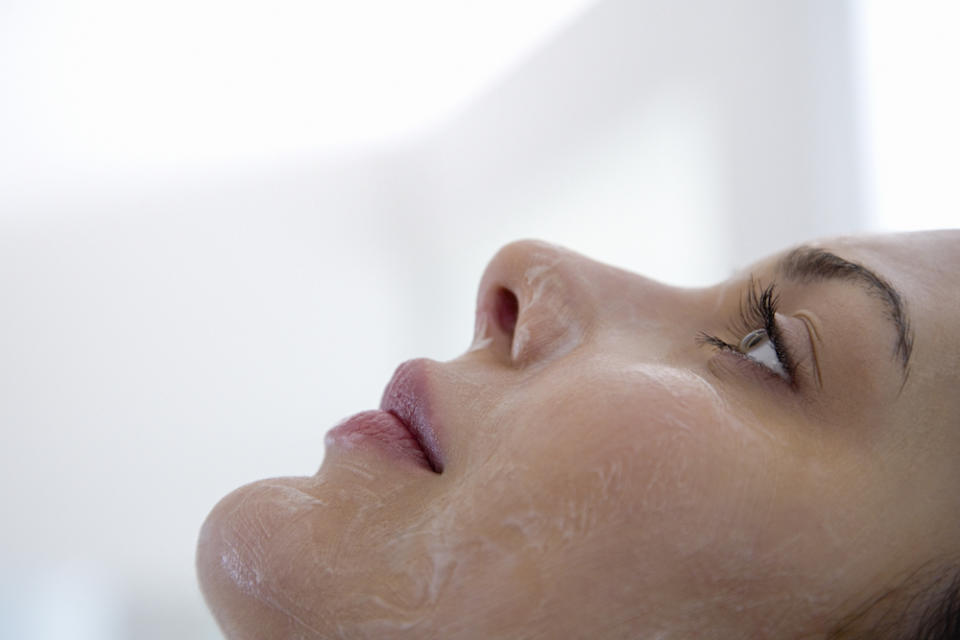What, exactly, is a chemical peel? An expert tells us all about the popular skin treatment

Chances are you’ve heard the term chemical peel, or at least have seen the Sex and the City episode where Samantha gets one that leaves her face tomato-red. But even though chemical peels are the third most commonly performed noninvasive cosmetic procedures in the U.S., many people may still be unsure just what good (or bad) they can do for our skin.
According to the board-certified dermatologist and celebrity beauty expert, Dr. Anna Gaunche, M.D., a chemical peel is when an acidic chemical solution is carefully applied to the skin to induce peeling and skin sloughing to help reveal smoother, fresher-looking skin. “When acid is applied, the dead skin cells are let go, which results in peeling and accelerates skin cell turnover,” Dr. Gauche tells HelloGiggles. “Skin cells are actually replaced every 45 days!” Talk about a brand new you.

The first thing to know is that there are several different types of peels, ranging from superficial or light peels to medium peels and finally deep peels, which can sometimes require an overnight stay. There are also different types of ingredients used. Glycolic peels penetrate deeply and are good for aging skin. Lactic peels are good for those with skin that’s dry or sensitive. Beta-hydroxy peels contain salicylic acid, making them best for acne patients.
There are, of course, at-home products that have the same kinds of ingredients as professional peels done by your dermatologist but are just milder. If you’ve ever used the Drunk Elephant Babyfacial, then you’ve done a peel, as it contains glycolic, tartaric, lactic, citric, and salicylic acids. The Dr. Dennis Gross Alpha Beta Universal Daily Peel pads contain AHAs and BHAs, and can help with photoaging, uneven tone, and scars.
A post shared by 𝘼𝙣𝙣𝙖 𝙂𝙪𝙖𝙣𝙘𝙝𝙚 𝙈𝘿 𝙁𝘼𝘼𝘿 (@annaguanchemd) on Feb 2, 2019 at 5:58pm PST
Below, Dr. Guanche tells us everything we need to know about chemical peels.
HelloGiggles: What are the benefits of a chemical peel?
Dr. Gaunche: Chemical peels are beneficial to help fight the signs of aging. They are used to refresh and renew the appearance of the skin. They often help to soften fine lines and wrinkles, and lighten brown spots. Certain chemicals can be used to target pigment or even acne. Once peeled, the skin looks brighter and more even.
HG: Is there a certain skin type that benefits best from chemical peels?
Dr. Guanche: Chemical peels work best for those that have fair/medium skin types. The darker the skin, the more risk there is of pigmentation issues and other poor outcomes with peels; of course, this depends on whether it is a superficial, medium, or deep peel. Choosing an experienced physician is key to good outcomes.
HG: Can you walk us through the process?
Dr. Guanche: First, the skin is prepped with acetone in order to “de-fat” the skin. Next, the peeling solution is applied to the skin very strategically. The well-trained physician will be looking for reactions in the skin such as redness, and frosting (skin turns white as proteins are digested). The peel is then neutralized by either a solution/cream or by the client washing their face. Then, topical aftercare is applied, including sunscreen.
HG: What is the recovery and aftercare like?
Dr. Guanche: This depends on which type of peel. For light chemical peels like Jessner’s, there is very little downtime. For deeper peels, like Phenol peels, sometimes a stay at a hospital is needed. Downtime must always be discussed with the provider before partaking in a peel treatment.
A post shared by 𝘼𝙣𝙣𝙖 𝙂𝙪𝙖𝙣𝙘𝙝𝙚 𝙈𝘿 𝙁𝘼𝘼𝘿 (@annaguanchemd) on Mar 19, 2019 at 12:01pm PDT
HG: How soon can someone see results?
Dr. Guanche: Some peels make your skin look amazing right after the peel. Some peels take five to seven days to see their full effect. This, again, should be discussed with the doctor.
HG: What are the risks of a chemical peel?
Dr. Guanche: The risks of chemical peels are hypopigmentation, hyperpigmentation, scars, redness, uneven peeling, irritation, allergic reaction, and dermatitis or rash. Sounds scary, but I do them all day long and have minimal to no problems. These are the known risks and really depend on the experience level of the provider.

